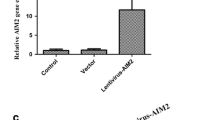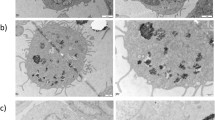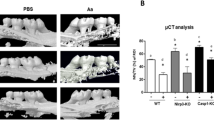Abstract
Release of titanium ions (Ti ions) frequently occurs around dental implants and, as a consequence, higher content of Ti is typically present in peri-implantitis tissue. Unlike chronic periodontitis, Ti ions may play a role in the development of peri-implantitis. Inflammasomes are multiprotein signal transduction complexes, involved in inflammation and immune response, which lead to the secretion of mature cytokines associated with the progression of peri-implantitis. It is well known that T lymphocytes dominate the immune response in peri-implantitis, but whether Ti ions can impact the assembly of functional inflammasomes in T cells still remains unclear. Here, we observed that the mRNA expression of NLRP3 and CASP1, as well as the secretion of IL-1β, increased after 6-h incubation of Jurkat T cells with PHA and Ti ions. Moreover, measurement by confocal microscopy and flow cytometry assay indicates that Ti ions can promote the production of ROS, while NLRP3 expression and IL-1β secretion are reduced after treatment of Jurkat cells with NAC (ROS scavenger). Taken together, we presently show that Ti ions can activate NLRP3 inflammasome and then promote IL-β secretion in vitro, where ROS may play a mechanistic role in this activation process.




Similar content being viewed by others
Abbreviations
- NAC:
-
N-acetyl cysteine
- PHA:
-
phytohaemagglutinin
- NLRP1:
-
NLR family, pyrin domain containing 1
- AIM2:
-
absent in melanoma 2
- NLRP3:
-
NLR family, pyrin domain containing 3
- NLRC4:
-
NLR family CARD domain-containing protein 4
- ASC:
-
apoptosis-associated speck-like protein containing a CARD
- DCF:
-
2′,7′-dichlorodihydrofluorescein
References
Derks, J., and C. Tomasi. 2015. Peri-implant health and disease. A systematic review of current epidemiology. Journal of Clinical Periodontology 42 (Suppl 16): S158–S171.
Schwarz, F., J. Derks, A. Monje, and H.L. Wang. 2018. Peri-implantitis. Journal of Periodontology 89 (Suppl 1): S267–S290.
Albrektsson, T., L. Canullo, D. Cochran, and H. De Bruyn. 2016. “Peri-Implantitis”: a complication of a foreign body or a man-made “disease”. Facts and Fiction. Clinical Implant Dentistry and Related Research 18 (4):840–849.
Matono, Y., M. Nakagawa, S. Matsuya, K. Ishikawa, and Y. Terada. 2006. Corrosion behavior of pure titanium and titanium alloys in various concentrations of acidulated phosphate fluoride (APF) solutions. Dental Materials Journal 25 (1): 104–112.
Nakagawa, M., S. Matsuya, and K. Udoh. 2002. Effects of fluoride and dissolved oxygen concentrations on the corrosion behavior of pure titanium and titanium alloys. Dental Materials Journal 21 (2): 83–92.
de Morais, L.S., G.G. Serra, E.F. Albuquerque Palermo, L.R. Andrade, C.A. Müller, M.A. Meyers, and C.N. Elias. 2009. Systemic levels of metallic ions released from orthodontic mini-implants. American Journal of Orthodontics and Dentofacial Orthopedics 135 (4): 522–529.
Schliephake, H., G. Reiss, R. Urban, F.W. Neukam, and S. Guckel. 1993. Metal release from titanium fixtures during placement in the mandible an experimental study. The International Journal of Oral & Maxillofacial Implants 8: 502–511.
Meyer, U., M. Bühner, A. Büchter, B. Kruse-Lösler, T. Stamm, and H.P. Wiesmann. 2006. Fast element mapping of titanium wear around implants of different surface structures. Clinical Oral Implants Research 17 (2): 206–211.
Wennerberg, A., A. Ide-Ektessabi, S. Hatkamata, T. Sawase, C. Johansson, T. Albrektsson, A. Martinelli, U. Södervall, and H. Odelius. 2004. Titanium release from implants prepared with different surface roughness. Clinical Oral Implants Research 15 (5): 505–512.
Chen, J., Q. Li, Z. Pang, M. Gong, and L. Tang. 2018. Titanium ions promote exogenous calcium-dependent calcium influx in activated Jurkat T cells: a possible mechanism to explain its immunostimulatory properties. Mediators of Inflammation 2018: 3286905.
Ghassib, I., Z. Chen, J. Zhu, and H.L. Wang. 2019. Use of IL-1 beta, IL-6, TNF-alpha, and MMP-8 biomarkers to distinguish peri-implant diseases: a systematic review and meta-analysis. Clinical Implant Dentistry and Related Research 21 (1): 190–207.
Makihira, S., Y. Mine, H. Nikawa, T. Shuto, S. Iwata, R. Hosokaw, K. Kamoia, S. Okazaki, and Y. Yamaguchi. 2010. Titanium ion induces necrosis and sensitivity to lipopolysaccharide in gingival epithelial-like cells. Toxicology In Vitro 24 (7): 1905–1910.
Pettersson, M., J. Pettersson, A. Johansson, and M. Molin Thoren. 2019. Titanium release in peri-implantitis. Journal of Oral Rehabilitation 46 (2): 179–188.
Brewer, S.M., S.W. Brubaker, and D.M. Monack. 2019. Host inflammasome defense mechanisms and bacterial pathogen evasion strategies. Current Opinion in Immunology 60: 63–70.
Latz, E., T. Sam Xiao, and A. Stutz. 2013. Activation and regulation of the inflammasomes. Nature Reviews Immunology 13 (6): 397–411.
Man, S.M., and T.D. Kanneganti. 2016. Converging roles of caspases in inflammasome activation, cell death and innate immunity. Nature Reviews. Immunology 16 (1): 7–21.
Creagh, E.M. 2014. Caspase crosstalk: integration of apoptotic and innate immune signalling pathways. Trends in Immunology 35 (12): 631–640.
Dinarello, C.A. 2009. Immunological and inflammatory functions of the interleukin-1 family. Annual Review of Immunology 27: 519–550.
Obando-Pereda, G.A., L. Fischer, and D.R. Stach-Machado. 2014. Titanium and zirconia particle-induced pro-inflammatory gene expression in cultured macrophages and osteolysis, inflammatory hyperalgesia and edema in vivo. Life Sciences 97 (2): 96–106.
Broz, P., and V.M. Dixit. 2016. Inflammasomes: mechanism of assembly, regulation and signalling. Nature Reviews. Immunology 16 (7): 407–420.
Swanson, K.V., M. Deng, and J.P. Ting. 2019. The NLRP3 inflammasome: molecular activation and regulation to therapeutics. Nature Reviews. Immunology 19 (8): 477–489.
Tschopp, J., and K. Schroder. 2010. NLRP3 inflammasome activation: the convergence of multiple signalling pathways on ROS production? Nature Reviews. Immunology 10 (3): 210–215.
Moussa, H., C. Merlin, C. Dezanet, L. Balan, G. Medjahdi, M. Ben-Attia, and R. Schneider. 2016. Trace amounts of Cu(2)(+) ions influence ROS production and cytotoxicity of ZnO quantum dots. Journal of Hazardous Materials 304: 532–542.
Wei, X., X. Zhang, L.M. Flick, H. Drissi, E.M. Schwarz, and R.J. O'Keefe. 2009. Titanium particles stimulate COX-2 expression in synovial fibroblasts through an oxidative stress-induced, calpain-dependent, NF-κB pathway. American Journal of Physiology-Cell Physiology 297 (2): C310–C320.
Galindo-Moreno, P., J. López-Martínez, M. Caba-Molina, R. Ríos-Pelegrina, L. Torrecillas-Martínez, A. Monje, F. Mesa, N. Chueca, F. García-García, and F. O'Valle. 2017. Morphological and immunophenotypical differences between chronic periodontitis and peri-implantitis – a cross-sectional study. European Journal of Oral Implantology 10 (4): 453–463.
Kummer, J.A., R. Broekhuizen, H. Everett, L. Agostini, L. Kuijk, F. Martinon, R. van Bruggen, and J. Tschopp. 2007. Inflammasome components NALP 1 and 3 show distinct but separate expression profiles in human tissues suggesting a site-specific role in the inflammatory response. The Journal of Histochemistry and Cytochemistry 55: 443–452.
Arbore, G., E.E. West, R. Spolski, A.A.B. Robertson, A. Klos, C. Rheinheimer, P. Dutow, et al. 2016. T helper 1 immunity requires complement-driven NLRP3 inflammasome activity in CD4(+) T cells. Science 352 (6292): aad1210.
Chen, X., Z. Zhong, Z. Xu, L. Chen, and Y. Wang. 2010. 2′,7′-Dichlorodihydrofluorescein as a fluorescent probe for reactive oxygen species measurement: forty years of application and controversy. Free Radical Research 44 (6): 587–604.
Davis-Gilbert, Z.W., and I.A. Tonks. 2017. Titanium redox catalysis: insights and applications of an earth-abundant base metal. Dalton Transactions 46 (35): 11522–11528.
Berglundh, T., S. Jepsen, B. Stadlinger, and H. Terheyden. 2019. NLRP1 and NLRC4 inflammasomes are not responsible for the induction of inflammation in pulp tissues from carious teeth. Journal of Conservative Dentistry 22 (1): 12–16.
Hornung, V., A. Ablasser, M. Charrel-Dennis, F. Bauernfeind, G. Horvath, D.R. Caffrey, E. Latz, and K.A. Fitzgerald. 2009. AIM2 recognizes cytosolic dsDNA and forms a caspase-1-activating inflammasome with ASC. Nature 458 (7237): 514–518.
Jo, E.K., J.K. Kim, D.M. Shin, and C. Sasakawa. 2016. Molecular mechanisms regulating NLRP3 inflammasome activation. Cellular & Molecular Immunology 13 (2): 148–159.
Martinon, F., A. Mayor, and J. Tschopp. 2009. The inflammasomes: guardians of the body. Annual Review of Immunology 27: 229–265.
Schroder, K., and J. Tschopp. 2010. The inflammasomes. Cell 140 (6): 821–832.
Vanaja, S.K., V.A. Rathinam, and K.A. Fitzgerald. 2015. Mechanisms of inflammasome activation: recent advances and novel insights. Trends in Cell Biology 25 (5): 308–315.
Pettersson, M., P. Kelk, G.N. Belibasakis, D. Bylund, M. Molin Thoren, and A. Johansson. 2017. Titanium ions form particles that activate and execute interleukin-1beta release from lipopolysaccharide-primed macrophages. Journal of Periodontal Research 52 (1): 21–32.
Awad, F., E. Assrawi, C. Louvrier, C. Jumeau, S. Georgin-Lavialle, G. Grateau, S. Amselem, I. Giurgea, and S.A. Karabina. 2018. Inflammasome biology, molecular pathology and therapeutic implications. Pharmacology & Therapeutics 187: 133–149.
Ferreira, S.D., C.C. Martins, S.A. Amaral, T.R. Vieira, B.N. Albuquerque, L.O.M. Cota, R.P. Esteves Lima, and F.O. Costa. 2018. Periodontitis as a risk factor for peri-implantitis: systematic review and meta-analysis of observational studies. Journal of Dentistry 79: 1–10.
Broz, P., J. von Moltke, J.W. Jones, R.E. Vance, and D.M. Monack. 2010. Differential requirement for caspase-1 autoproteolysis in pathogen-induced cell death and cytokine processing. Cell Host & Microbe 8 (6): 471–483.
Dick, M.S., L. Sborgi, S. Ruhl, S. Hiller, and P. Broz. 2016. ASC filament formation serves as a signal amplification mechanism for inflammasomes. Nature Communications 7: 11929.
Van Opdenbosch, N., P. Gurung, L. Vande Walle, A. Fossoul, T.D. Kanneganti, and M. Lamkanfi. 2014. Activation of the NLRP1b inflammasome independently of ASC-mediated caspase-1 autoproteolysis and speck formation. Nature Communications 5: 3209.
Dostert, C., V. Petrilli, R. Van Bruggen, C. Steele, B.T. Mossman, and J. Tschopp. 2008. Innate immune activation through Nalp3 inflammasome sensing of asbestos and silica. Science 320 (5876): 674–677.
Milkovic, L., A. Cipak Gasparovic, M. Cindric, P.A. Mouthuy, and N. Zarkovic. 2019. Short overview of ROS as cell function regulators and their implications in therapy concepts. Cells 8 (8): 793–807.
Abais, J.M., M. Xia, Y. Zhang, K.M. Boini, and P. Li. 2015. Redox regulation of NLRP3 inflammasomes: ROS as trigger or effector? Antioxidants & Redox Signaling 22 (13): 1111–1129.
Ferko, M.A., and I. Catelas. 2018. Effects of metal ions on caspase-1 activation and interleukin-1beta release in murine bone marrow-derived macrophages. PLoS One 13 (8): e0199936.
Niki, Y., H. Matsumoto, Y. Suda, T. Otani, K. Fujikawa, Y. Toyama, N. Hisamori, and A. Nozue. 2003. Metal ions induce bone-resorbing cytokine production through the redox pathway in synoviocytes and bone marrow macrophages. Biomaterials 24: 1447–1457.
Petit, A., F. Mwale, C. Tkaczyk, J. Antoniou, D.J. Zukor, and O.L. Huk. 2005. Induction of protein oxidation by cobalt and chromium ions in human U937 macrophages. Biomaterials 26 (21): 4416–4422.
Simon, F., D. Varela, and C. Cabello-Verrugio. 2013. Oxidative stress-modulated TRPM ion channels in cell dysfunction and pathological conditions in humans. Cellular Signalling 25 (7): 1614–1624.
Bouron, A., K. Kiselyov, and J. Oberwinkler. 2015. Permeation, regulation and control of expression of TRP channels by trace metal ions. Pflügers Archiv 467 (6): 1143–1164.
Funding
This study was supported by the National Natural Science Foundation of China (Grant 81460108).
Author information
Authors and Affiliations
Corresponding author
Ethics declarations
Conflict of Interest
The authors declare that they have no conflict of interest.
Additional information
Publisher’s Note
Springer Nature remains neutral with regard to jurisdictional claims in published maps and institutional affiliations.
Rights and permissions
About this article
Cite this article
Li, X., Tang, L., Ye Myat Thu et al. Titanium Ions Play a Synergistic Role in the Activation of NLRP3 Inflammasome in Jurkat T Cells. Inflammation 43, 1269–1278 (2020). https://doi.org/10.1007/s10753-020-01206-z
Published:
Issue Date:
DOI: https://doi.org/10.1007/s10753-020-01206-z




